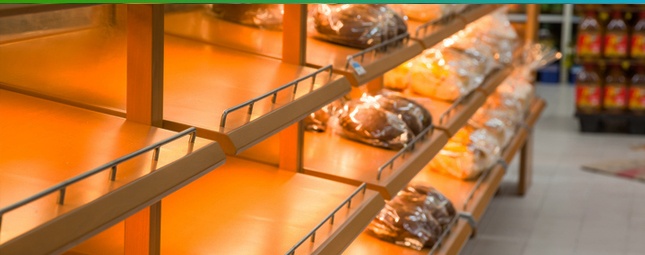3 of the Biggest Waste Culprits in Your Kitchen: Part 2—Fear of Running Out

As a chef I have had actual nightmares about running out of food. The kind of nightmares that wake you up in a sweat, with your heart beating out of your chest. The panic, the fear, the thought of facing angry customers because you are out of a menu favorite. Yep, the fear is real for chefs. With the relatively new voice of the consumer via social media—Yelp, Instagram, Facebook, blogs etc.—the chef and the restaurant are under constant scrutiny. And for many chefs, the backlash that can come from the public for an item being out on a menu far outweighs the logical thinking of just ordering what you need.
There are multiple reasons that a restaurant might have to “86” a menu item. Sometimes, there are restaurant menu items that aren’t supposed to last all service. It could be an new item on the restaurant’s menu that they are assessing if it sells, they may have gotten a great deal from a vendor on a limited amount of a product, or the item is seasonal and in limited supply. These types of menu items are usually communicated to the wait staff prior to service so they know for example if there are only 20 orders of this or 30 orders of that. As the service progresses, and these items are ordered, chances are the guests coming in later in the service won’t have the option to order these items.
Sometimes—and this does happen more that you would think—the product that was delivered is either spoiled or not up to the quality standards the restaurant expects. The chef has already planned the menu for the service and the product is not up to par and they are either faced with a quick menu change or just to tell guests that product is not available. If the chef can’t run to the store quickly to get a replacement, he/she is forced to do the latter.
A final reason the restaurant might run out of a particular menu item is one of the rarest cases, but it does happen--poor planning. No chef ever wants to run out, but it does happen. They misorder something or forget to order something. Or, just out of the blue, the reservations just come in quicker than expected and there is no time to order or prep a particular item. Overall poor kitchen management, but definitely possible in any restaurant.
All of this leads to a situation that no chef wants to face—an angry or disappointed guest because the item they want is unavailable. The amount a flak a restaurant can receive via social media for being out of an item is incredible, and in very rare circumstances, can cost a chef their job. This type of pressure leads to a typical practice of overbuying product so as not to EVER be out of an item on the menu. Overbuying typically leads to excess food waste. The chef would rather have wasted food than not have enough. It’s a vicious cycle and a fine line that the chef must walk as to not run out, but then again not have too much.
So what can a chef do to lessen the possibility of running out of product?
Here are some practices that every chef can put into place to help with the balance of running out versus overbuying:
Keep Accurate Records
Look back at sales, head counts, waste, and orders to gauge the predicted amount of food to order. Utilize strong forecasting procedures such as area events, weather, holidays etc. in order to properly forecast your expected guest count for the evening.
Based on Forecast, Place the Food Order Accordingly
Chefs should know, based on past records, their typical menu mix and have a pretty close estimate on how many of a particular item they are going to sell each service.
Communicate With the Service Staff and Guests
If the chef has a limited number of servings of a menu item, make sure the service staff know so they can communicate with the guests prior to ordering. Nothing frustrates a guest more than ordering something then being told the restaurant is out of that item.
Utilize Production Sheets
Based on forecasted headcount, the chef should put together production sheets so the kitchen staff knows how much to prep and the chef knows how much to order.
Menu Smart
Minimize the amount of menu items that rely on just one ingredient. Cross utilize as many ingredients as possible.
Use Order Guides!
I can’t believe the number of chefs I still see in this day and age that are not utilizing order guides when placing food orders. They rely on memory on what they think is in their walk in or dry storage. Use an order guide and physically walk the coolers, freezers and dry storages.
The Other Side of the Equation: Consumers
I feel I would be remiss if I did not discuss the other side of the equation that we, as consumers, bring to this issue. The nonstop onslaught of criticism given to a restaurant or chef if we happen to encounter an outage of a particular menu item at a restaurant. I think as a culture we have become so accustomed to having EVERYTHING we went WHEN we want it. We go to a restaurant because we have a craving for menu item “X.” The restaurant happens to be out of “X,” for whatever reason and we have this sense of entitlement that running out of “X” is unacceptable. So we tweet, post, and blog away at how awful it is that a restaurant ran out of the very item we wanted.
This is a significant part of this issue that needs solving. If we were much more forgiving as consumers, the chef and restaurant wouldn’t come under such fire. I mean is it really so bad that you go to a restaurant at 9:30 pm on a Saturday night and they were out of the “Braised Veal Cheek” feature? Must we, as consumers, start posting about how your evening was ruined and how awful the restaurant or chef is because they ran out of veal cheeks? This limited flex or forgiveness is the very reason chefs wake up in the middle of the night in a cold sweat. Believe me, I know.
Get more tips from LeanPath’s waste-fighting Chef Robb White in this recent on-demand webinar!
